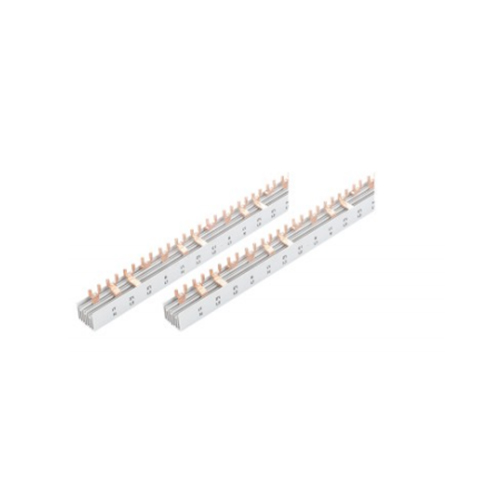The Essential Role of MCB Busbars in Electrical Systems
2025-01-04
In the world of electrical systems, safety, efficiency, and reliability are key factors that cannot be compromised. One of the crucial components that ensures these attributes in circuit protection is the MCB Busbar (Miniature Circuit Breaker Busbar). While often an overlooked element in many installations, the busbar plays a pivotal role in distributing electrical current safely across multiple MCBs (Miniature Circuit Breakers). In this blog, we will dive into the significance of MCB busbars, how they work, and why they are integral to modern electrical systems.
What is an MCB Busbar?
An MCB Busbar is a conductive metal bar used to distribute electrical current to multiple MCBs or circuit breakers in a control panel or electrical distribution board. The busbar typically serves as a central hub, providing a common connection point where electrical currents are efficiently distributed to each individual circuit breaker.
The busbar itself is usually made of high-conductivity materials such as copper or aluminum to ensure minimal resistance and efficient energy flow. It is designed to handle the electrical load and ensure that each circuit breaker receives the proper voltage to protect electrical circuits from overloads and short circuits.
Why is an MCB Busbar Important?
The MCB busbar plays several key roles in an electrical installation, and its importance extends beyond just being a connector for multiple circuit breakers:
1. Safe Distribution of Current: MCB busbars allow for the safe distribution of electrical power to multiple circuits. They are designed to carry current from a single source and distribute it without compromising safety or efficiency. This central distribution system ensures that each circuit breaker receives the necessary current to function properly.
2. Compact and Space-Saving Design: MCB busbars are an essential part of electrical panels, enabling multiple circuit breakers to be housed in a single compact unit. The use of a busbar helps eliminate the need for individual wires running from one circuit breaker to the next, saving space and reducing clutter in electrical panels.
3. Enhanced Reliability: Because busbars are typically made from high-quality conductive materials, they provide stable, reliable electrical connections. They ensure consistent and uninterrupted electrical flow, minimizing the risk of overheating, damage, or electrical failure.
4. Efficient Installation and Maintenance: MCB busbars streamline the installation process, as they allow for the quick and easy connection of multiple MCBs. They also make maintenance easier since any necessary adjustments or upgrades to the system can be carried out efficiently without the need to rewire multiple connections.
5. Cost-Effective: By reducing the amount of wiring and connections needed in an electrical panel, MCB busbars help lower the overall cost of materials and labor during installation. They also reduce the risk of faulty connections, which could lead to costly repairs down the line.
How Do MCB Busbars Work?
MCB busbars work by providing a centralized distribution point for electricity. Here’s a simplified breakdown of how they operate:
- Electrical Source Input: The electrical current enters the system from an external power source (such as a transformer or distribution board).
- Current Flow: The busbar acts as the conductor, carrying the incoming electrical current and distributing it to each MCB. The current flows through the busbar to various output terminals.
- Circuit Breaker Protection: Each MCB connected to the busbar protects an individual circuit by monitoring the current passing through it. If the current exceeds a preset limit (due to overload or a short circuit), the MCB automatically disconnects the circuit to prevent further damage to the system.
The MCB busbar ensures that the distribution of electricity is both organized and efficient, allowing each MCB to manage specific circuits while maintaining the safety of the entire electrical system.
Types of MCB Busbars
MCB busbars come in various forms, depending on the specific needs of the electrical system. Some common types include:
1. Single-Phase Busbars: These are typically used in smaller electrical systems where only a single-phase current is required. They are usually found in residential electrical installations or smaller commercial applications.
2. Three-Phase Busbars: Three-phase MCB busbars are commonly used in larger commercial or industrial electrical systems. They are designed to distribute three-phase power, which is needed for high-demand applications. Three-phase busbars allow for more efficient power distribution across the system.
3. Isolated Busbars: In some cases, isolated busbars are used to ensure that each MCB is electrically separated from others, minimizing the risk of cross-circuit issues. This is especially important in more complex or sensitive systems.
4. Busbar Trunking Systems: This is a more advanced form of busbar that includes a pre-assembled, insulated system designed for easy installation in commercial or industrial settings. These systems are often modular and flexible, allowing for quick reconfiguration as the electrical system evolves.
Benefits of MCB Busbars
1. Increased Safety: The primary purpose of MCBs is to provide circuit protection, and the MCB busbar plays a critical role in making sure the MCBs function as intended. By providing reliable connections and centralized distribution, busbars reduce the chances of electrical malfunctions or overloads that could pose safety risks.
2. Flexibility: MCB busbars can easily be configured to meet the specific needs of the installation. Whether you’re working with single-phase or three-phase systems, busbars can be adapted to accommodate various configurations, making them versatile and scalable.
3. Durability and Longevity: Since busbars are typically made from corrosion-resistant materials like copper and aluminum, they are highly durable. This long-lasting quality ensures that the electrical system will perform reliably for years, reducing maintenance needs and operational disruptions.
4. Improved Energy Efficiency: By reducing energy losses that occur with traditional wiring and connections, MCB busbars help improve the overall energy efficiency of electrical systems. The minimized resistance provided by busbars means that less energy is lost in transit, leading to a more sustainable and cost-effective setup.
Considerations When Installing an MCB Busbar
While MCB busbars provide many advantages, there are a few considerations to keep in mind during installation:
- Sizing: It's essential to ensure that the busbar is appropriately sized to handle the electrical load. An undersized busbar could lead to overheating or system failure, while an oversized busbar could increase installation costs unnecessarily.
- Material Selection: Choose the right material for the busbar based on the specific needs of the installation. Copper is highly conductive and ideal for high-performance systems, while aluminum may be a more cost-effective option for lower-demand applications.
- Quality Assurance: Always ensure that the busbar and its components meet international safety and quality standards to prevent electrical hazards. Look for certifications such as UL, IEC, or CE when selecting your MCB busbar.
Conclusion
MCB busbars may not always get the attention they deserve, but they are integral to the smooth and safe operation of electrical systems. By efficiently distributing electrical current to multiple MCBs, busbars help maintain safety, reliability, and cost-effectiveness in both residential and commercial electrical installations. Whether you're working on a small home setup or a large industrial system, understanding the role of MCB busbars and choosing the right one for your needs is critical in ensuring the long-term success and safety of your electrical infrastructure.



